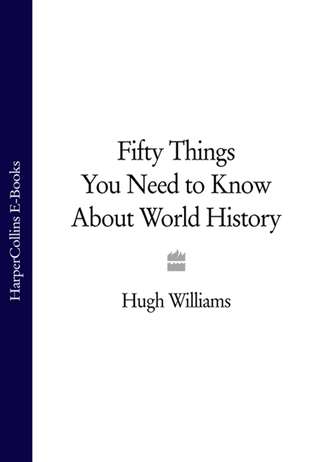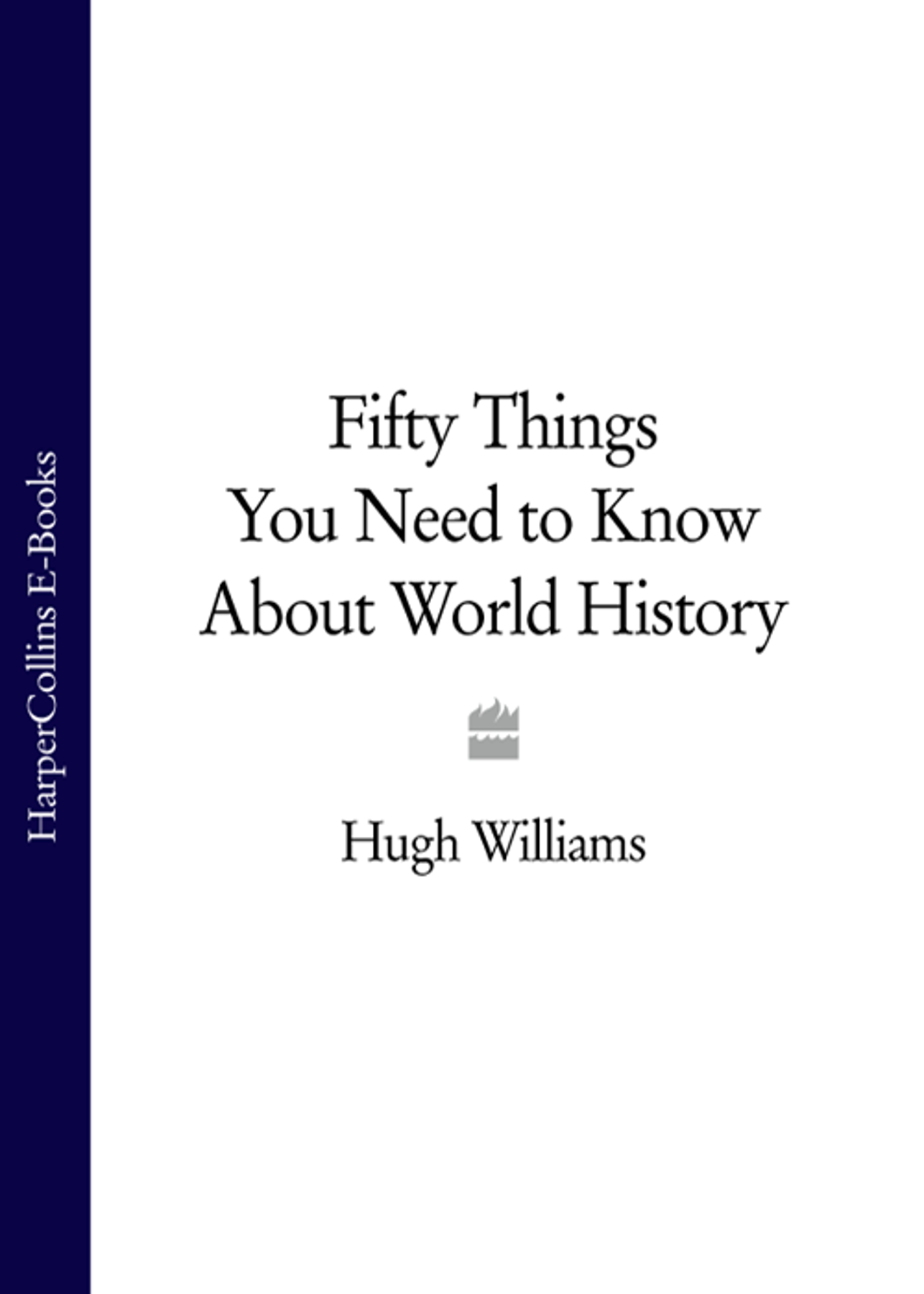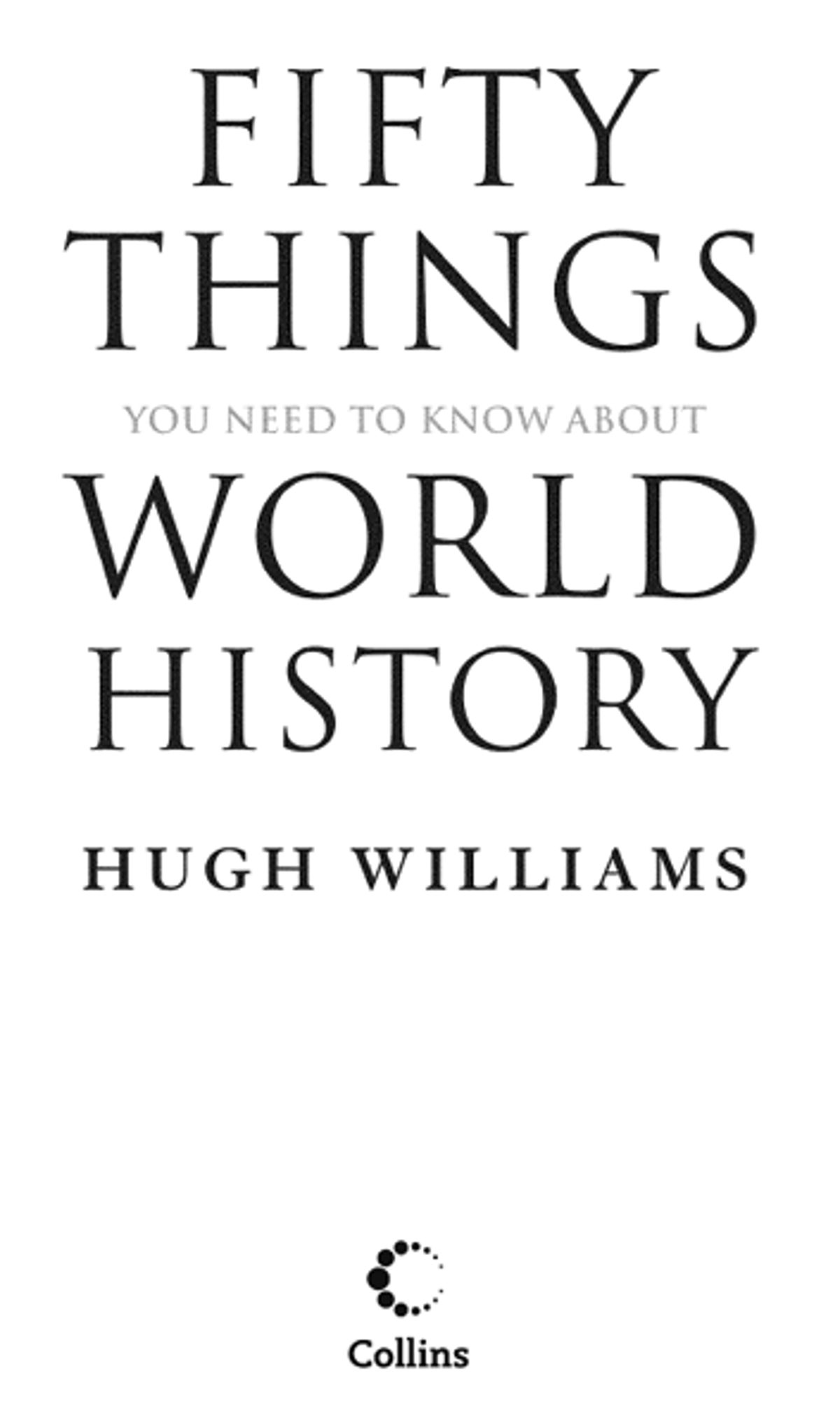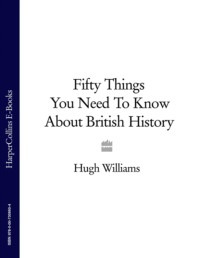
Полная версия
Fifty Things You Need to Know About World History



Copyright
First published in 2010 by Collins
an imprint of HarperCollinsPublishers Ltd. 1 London Bridge Street London SE1 9GF
www.harpercollins.co.uk
13 12 11 10 09
9 8 7 6 5 4 3 2 1
Text © Hugh Williams 2010
Hugh Williams asserts his moral right to be identified as the author of this work
A catalogue record for this book is available from the British Library
All rights reserved under International and Pan-American Copyright Conventions. By payment of the required fees, you have been granted the non-exclusive, non-transferable right to access and read the text of this ebook on-screen. No part of this text may be reproduced, transmitted, down-loaded, decompiled, reverse engineered, or stored in or introduced into any information storage and retrieval system, in any form or by any means, whether electronic or mechanical, now known or hereinafter invented, without the express written permission of HarperCollins ebooks.
HarperCollinsPublishers has made every reasonable effort to ensure that any picture content and written content in this ebook has been included or removed in accordance with the contractual and technological constraints in operation at the time of publication
Source ISBN: 9780007326501
Ebook Edition © AUGUST 2010 ISBN: 9780007411115 Version: 2018-07-18
Contents
Cover
Title Page
Copyright
Introduction
1 Wealth
Introduction
CHAPTER 1 The Building of the Via Egnatia 146 BC
CHAPTER 2 The City of Chang’an 750 AD
CHAPTER 3 The Travels of Marco Polo 1271–95
CHAPTER 4 The Black Death 1348–50
CHAPTER 5 The Foundation of the Dutch East India Company 1602
CHAPTER 6 The Invention of the Flying Shuttle 1733
CHAPTER 7 The Foundation of Oil City, Pennsylvania 1859
CHAPTER 8 The Treaty of Versailles 1919
CHAPTER 9 The Model T Ford 1908
CHAPTER 10 The Credit Crunch 2007
2 Freedom
Introduction
CHAPTER 1 Spartacus 73 BC
CHAPTER 2 The Burning of Jan Hus 1415
CHAPTER 3 The American Declaration of Independence 1776
CHAPTER 4 The French Revolution 1789
CHAPTER 5 Ludwig van Beethoven’s Ninth Symphony 1824
CHAPTER 6 The Zulu War 1879
CHAPTER 7 The Russian Revolution 1917
CHAPTER 8 Mao Zedong and the People’s Republic of China 1949
Plates 1
CHAPTER 9 The Fall of the Berlin Wall 1989
CHAPTER 10 The Release of Nelson Mandela 1990
3 Religion
Introduction
CHAPTER 1 The Epic of Gilgamesh 2000 BC
CHAPTER 2 The Mahabharata 500–100 BC
CHAPTER 3 Plato 429–347 BC
CHAPTER 4 Buddha c.400 BC
CHAPTER 5 Confucius 551–479 BC
CHAPTER 6 The Crucifixion of Jesus 33 AD
CHAPTER 7 The Death of Mohammed 632 AD
CHAPTER 8 Martin Luther’s Ninety-Five Theses 1517
CHAPTER 9 Charles Darwin’s On the Origin of Species 1859
CHAPTER 10 9/11 2001
4 Conquest
Introduction
CHAPTER 1 Ozymandias (Rameses II) 1279–C.1213 BC
Plates 2
CHAPTER 2 Alexander the Great 356–323 BC
CHAPTER 3 The Sack of Rome 410 AD
CHAPTER 4 The Coronation of Charlemagne 800 AD
CHAPTER 5 Chinggis Khan Becomes Sole Ruler of the Mongol People 1206
CHAPTER 6 The Fall of Constantinople 1453
CHAPTER 7 The Conquest of Mexico 1521
CHAPTER 8 The Exile of Napoleon Bonaparte to St Helena 1815
CHAPTER 9 The Indian Mutiny 1857
CHAPTER 10 Hiroshima 1945
5 Discovery
Introduction
CHAPTER 1 Archimedes of Syracuse 287–212 BC
CHAPTER 2 The Chinese Invention of Printing, seventh century AD
CHAPTER 3 Leonardo da Vinci 1452–1519
CHAPTER 4 Vasco da Gama Discovers a Sea Route to India 1498
CHAPTER 5 Sir Isaac Newton Publishes the Principia 1687
CHAPTER 6 Australia’s First Colony 1788
CHAPTER 7 John Logie Baird Demonstrates the First Moving Television Images 1926
CHAPTER 8 The Discovery of the Structure of DNA Helix 1953
CHAPTER 9 Apollo 11 Lands on the Moon 1969
CHAPTER 10 The Creation of the Worldwide Web 1990
Index
Acknowledgements
ALSO BY HUGH WILLIAMS
About the Publisher
Introduction
The world in which we live is growing smaller, and shrinking. There is hardly a corner of it that has not at some time or another appeared on television in our homes. The activities of African, Asian and Middle Eastern politicians are often as familiar to us as those in our own country. The world is a bubble into which, thanks to the internet and other forms of mass communication, we peer at will. But where do we fit into the seething mass we see? What do we have in common with other people, places, cultures and ideas? What do they share with us?
One book cannot possibly answer all those questions but, with the help of history, it can provide a guide. History is one of the most important things that we possess: knowing about the past helps us manage the present and plan the future. And today we need a knowledge of history more than we have ever done before. Our world may be smaller but it is also more complex. We have become participants in even its most extreme activities. We watch the progress of wars on CNN or the BBC and, if we want, travel to its most dangerous places. I read a newspaper report recently about an elderly British pensioner who spends his time visiting Afghanistan, Iraq and North Pakistan. ‘You don’t think about roadside bombs, or being kidnapped,’ he said. ‘You know it happens, but you’re just too busy taking it all in.’ Exactly what he was taking in, the newspaper did not go on to say–presumably it was the experience of being there, of doing something unusual and rather dangerous. While we might admire the pluck and energy of someone taking his holidays in war zones, the fact that it happens at all is rather mystifying and confusing. Man was once an explorer: now he is just a tourist.
These extraordinary developments have helped create a world that is easy to see but difficult to understand. Discussions about world problems and their possible solutions are commonplace. People of influence think globally, in politics and economics, the environment and entertainment. At the same time we sometimes feel that our national identity is slipping away from us to be replaced by forces that are unfamiliar and uncertain. We would probably quite like to become citizens of the world, if only we knew what that meant. How should we balance national interests against global requirements? Where does our country end and the world begin?
The upheavals that surround us become inexplicable unless we can put them into some sort of context. That is one of the uses of history: to create a shape that helps make sense of the confusion in which we live. In 1919, H. G. Wells published The Outline of History in which he used his skill as a novelist to trace the history of mankind from prehistoric times to the present day. It was hugely popular. ‘The need for a common knowledge of the general facts of human history throughout the world,’ he wrote in the Introduction to a later edition, ‘has become very evident during the tragic happenings of the last few years.’ He might well have written exactly the same sentence were he to publish his book today. The world moves on and its glories and disasters move with it. We will always need help in understanding its history.
But, people will say, the history of the world is so big and so long that to take fifty things from it is impossible. It cannot be reduced to such a formula without becoming ridiculously oversimplified. That is always a danger. In history it is always easier to complicate than simplify. The fifty things described in this book are not the only fifty things you need to know about world history, to make that claim would be absurd, but they are fifty very important things each of which provides a vantage point from which to survey large historical trends. Some of them are huge, others comparatively small. Each is unique and made an important contribution to the way in which world civilisations changed and grew. Taken together they provide a structure, a framework, on which to hang the great events of history.
There is another obvious and fundamental question relating to the selection of events from world history. Where do you begin? And once you have decided on your starting place, where do you end? I am writing this in a house on the East Devon coast in Britain, which is now a World Heritage Site because its cliffs and rocks are millions of years old. Today this beautiful part of the country has a temperamental climate – wind, rain and sun in almost equal measure. Once, however, it was almost tropical and dinosaurs, whose fossilised footprints can still be found along its beaches, plodded around in burning heat. I used to spend a lot of holidays in the Dordogne area of south-west France where, in the caves around Les Eyzies, some of the earliest signs of primitive man were discovered in the latter half of the nineteenth century. As I paddled with my children down the gentle summer waters of one of France’s grandest rivers I could look up to the caves and hollows where Cro-Magnon once lived. He hunted with primitive spears and drew crude pictures of the world around him on the walls of his subterranean home. In September 1940, a few months after their country had fallen to German occupation in the Second World War, four teenagers stumbled on the wall paintings in the Lascaux Cave near Montignac, vivid pictures of horses, bulls and stags drawn by people who lived in the area 15,000 years ago.
Examples of ‘pre-history’, excitingly close to our everyday lives, are important in establishing how the world as a whole began to evolve. But in terms of explaining how mankind organised itself to create the world we recognise today, our starting point should be much later, at a time when man was beginning to organise himself into some sort of social structure, building places to live in rather than simply using the natural resources around him, and communicating in a language that was capable of being written down. This brings us forward to a time nearly 6,000 years ago, to the civilisation that existed in the Middle East in an area that today makes up Iraq and parts of Syria and Turkey.
The finishing point is more arbitrary. We can define a beginning, but we cannot predict the end. I can remember my wife, a journalist and broadcaster, asking me once what I thought she might say to a group of sixth-formers that she had been asked to address. The head teacher wanted her to come up with something that her pupils would find valuable and remember in later life. This was more than twenty years ago. The Berlin Wall had been torn down and we all felt optimistic and confident about the future. I suggested that she talk to them about a world that might at last be changing into a place of peace and prosperity. How wrong I was. Today world peace seems as distant as it ever was. As for prosperity, that too seems to have taken a battering thanks to the ceaseless turbulence in the financial markets. At the moment conflict and debt are the world’s stopping points, and it is with these that this history will end.
Though this book looks at events about 6,000 years ago, much of it is concerned with the events of the past few hundred years. That is a sobering thought. Mankind seems to have accelerated the pace of change as he has grown older. We know from our own lives how rapidly things develop from one generation to another. For most of us today, life without email would be unthinkable. It is actually quite difficult to buy a flight ticket unless you have a computer. But these inventions did not exist in any form whatsoever until I was a grown man, and are completely beyond the grasp of many people in the generation before mine. In the history of the world such rapid transformations are unusual. I would speculate that someone from 1700 would not have been as bewildered had he found himself living in 1800 as a person from 1900 transported to the year 2000. But just because transforming change seems to pick up speed with time, we should not make the mistake of putting more emphasis on events that have taken place more recently in any particular cycle. That would simply unbalance the narrative of the world’s historical development.
The other factor to take into account is the role of European civilisation. European people have been remarkably successful in spreading their practices and ideas around the world ever since mankind formed himself into discernible social groups. Their civilisation has tended to triumph where others have been lost. But the history of the world is not the history of Europe. It did not begin that way and, who knows, may not end that way either.
Throughout his life on earth, man has been driven by certain principal aspirations and I have taken some of these as the five themes of this book:
The first engine of man’s development has revolved around Wealth – the story of his ambition to be rich, and to buy and sell and make money through barter and exchange. This section is mainly about man as a trader and entrepreneur.
The second theme is Freedom – the story of the explosive ideas and inspiring people that have led man on his journey to become master of his individual fate, and to be free. This part of the book is about rebellion and revolution and the bravery of those who spoke or acted against oppression.
The third of man’s aspirations has been for Religion – the story of his continuing hope that his life has more lasting value than the one he spends on earth. This theme is used to describe the spread of the world’s religions and their heritage.
The fourth part of the book is about Conquest – the story of man’s appetite for expansion and territorial gain. This is all about the rise and fall of great empires, from the ancient world to the present day.
The fifth aspiration is Discovery – the story of man’s hunger to find and invent new things in the world around him in science and the arts. Here, some of the great inventions that have changed the nature of the world sit side by side with the achievements in exploration that improved our knowledge and understanding of it.
Inevitably there are times when these themes overlap, as the paths through our past crisscross one another. Religion was sometimes man’s motive for conquest; conquest was often carried out in search of wealth and so on. The Spanish conquest of South America in the sixteenth century is a good example. The conquistadors were motivated by both religious conviction and a desire for riches and their story might have been included in more than one place.
A good history book should be a companion as well as a teacher. It should help people understand as well as simply learn. From understanding comes confidence and hope, two feelings that sometimes seem in rather short supply in the world today. So if history can help us understand perhaps it can also help to inspire. And why not? After all, the world is ours: we owe it to ourselves to enjoy it.
Introduction
Most of the children described in Hilaire Belloc’s Cautionary Verses come to a sticky end. Matilda, who lies, is burned to death; Henry King, who chews string, dies from knots in his stomach; and Godolphin Horne, who is excruciatingly superior, becomes a bootblack at the Savoy. Only one child is saved from misfortune – the obsequiously good, horribly nice Charles Augustus Fortescue.
In eating Bread he made no Crumbs, He was extremely fond of sums,
To which, however, he preferred The Parsing of a Latin Word–
Such assiduous, good behaviour brings its just reward:
He rose at once in his Career, And long before his Fortieth Year
Had wedded Fifi, Only Child Of Bunyan, First Lord Aberylde. He thus became immensely Rich, And built the Splendid Mansion which
Is called ‘The Cedars, Muswell Hill’. Where he resides in Affluence still, To show what Everybody might Become by SIMPLY DOING RIGHT.
The gentle satire of Belloc’s comic verse, written at the very beginning of the twentieth century, has some relevance to life in Britain today. Men like Charles Augustus Fortescue still exist, their apparently effortless success a source of bewilderment and envy. How did they do it? Why have they been blessed with so much money? The way in which people set about acquiring wealth, and how they use it once they have got it, has preoccupied mankind for centuries.
Most human beings want to be richer than they are. In the English language there is a difference of meaning, or at least of usage, in the words ‘wealth’ and ‘riches’. Wealth implies a sense of prosperity shared for the common good. Adam Smith’s The Wealth of Nations, published in 1776, the same year as the American Declaration of Independence, has come to be seen as the great rational defence of capitalism, just as the United States has become its most controversial exponent. In this context ‘wealth’ means the collective output of a free market whose different functions reinforce one another to the benefit of all. We tend to use the word ‘riches’ rather differently. Riches can be envied as much as enjoyed. To be rich you need to have done better, or been luckier, than your fellow men. It denotes individual good fortune rather than social wellbeing. Man works to be wealthy, but gambles to be rich.
The fact remains, however, that a society cannot be wealthy unless at least some of its members are rich. And wealth cannot be created unless individuals are motivated to acquire riches. How people become rich – in other words, whether or not they can be said to have earned their wealth – lies at the heart of our attitude towards this whole subject. As I write, Britain is engulfed in a scandal about MPs’ expenses. Many of them have been exposed for making extravagant and dishonest claims for the maintenance of their second homes. People are angry because they believe those they elected to be the guardians of the nation’s money have behaved like cheats, trying to become richer without earning the privilege. Unearned wealth is not to be tolerated.
But what do we mean by ‘unearned’ wealth? Less than a hundred years after Adam Smith explained the advantages of a free market, Karl Marx described its dangers. Where Smith saw benevolent prosperity, Marx found exploitation and inequality. The huge process of industrialisation, which was beginning to rumble into action when The Wealth of Nations was published, had, in Marx’s view, resulted in social and economic divisions that could only end in tension and conflict. How man has coped with wealth and defined both its benefits and drawbacks is an essential part of world history.
This chapter is about man’s acquisition, and sometimes loss, of wealth and its consequences. It begins with the building of the Via Egnatia that carried the traffic of the Romans across the Balkans from the Adriatic to Constantinople. The Roman road system supported the wealth of the greatest of the empires in world history, helping to maintain a centralised grip on the huge territory it controlled. The chapter then explores the city of Chang’an in China, the first great city of the world – richer and larger than anything Europe would see for hundreds of years afterwards. Marco Polo and his family risked their lives in search of wealth, travelling from Venice to China towards the end of the thirteenth century. But in the middle of the fourteenth century the wealth that Europe had begun to enjoy from its expanding trade was nearly destroyed by the arrival of the Black Death. At the beginning of the seventeenth century the foundation of the Dutch East India Company demonstrated how easily merchants could become princes, and how money could rule the world. The invention of the Flying Shuttle in the early eighteenth century was a simple improvement to the business of weaving that, though small in itself, was the first step along a process of industrialisation that led to the biggest revolution in wealth-creation the world had ever seen. The discovery of oil in America accelerated that process and made some individuals fabulously rich. After the First World War, a failure to understand the economic interests of different countries lay at the heart of the Treaty of Versailles which, in trying to put Europe back together again, only succeeded in preparing it for another terrible war. Meanwhile the invention of the Model T Ford ushered in an age of consumerism: many more people could now at least feel rich if they wanted to. Finally, in our own time, the Credit Crunch brought to an end a period of continuous wealth expansion as people discovered that good times are never forever. From the tramp of Roman legions across the packed sand of a Balkan highway to the hideous devastation of the plague and the calculated ruthlessness of sober Amsterdam businessmen, from the belching ferocity of the Industrial Revolution to the economic failures of the Treaty of Versailles and the remorseless spread of the motor car, the history of mankind is a history of trying to get rich and stay rich.
CHAPTER 1
The Building of the Via Egnatia 146 BC
The Via Egnatia was a Roman road that stretched from the Albanian port of Durres on the Adriatic coast to Istanbul. It carried commercial and military traffic across the Balkans and through Greece and Turkey, sustaining the wealth of a great empire.
For nearly a thousand years, the Romans ruled an empire the like of which the world had never seen before, and has not seen since. Their rise to power began at the beginning of the fifth century BC when, as a republic, they elected their first ruling consuls. It ended with the sack of Rome, by then just another city in only half the empire, by the Goths in 410 AD. At its height, after the conquest of Britain in the first century AD, the empire covered all of North Africa, the Middle East, Asia Minor, the Balkans and most of Western Europe including Spain, France, the German lands and Italy. But its size, though vast, was not the most impressive thing about it. Its extraordinary achievement – one that has never been equalled in the history of the world – was the degree of organisation and control that it brought and then maintained to the disparate territories under its authority. When St Paul, a converted Jew from the town of Tarsus in Anatolia (in what is now eastern Turkey), fell foul of the law for his preaching about Christianity, he could claim that he was a Roman citizen – ‘civis Romanus sum’ – and therefore be sent to Rome for trial. Whether patrolling the bleak landscape on the border between occupied Britain and Pictish Scotland, or marching through the desert in the conquered provinces of North Africa, a Roman lived under the same laws and was entitled to the same treatment.





